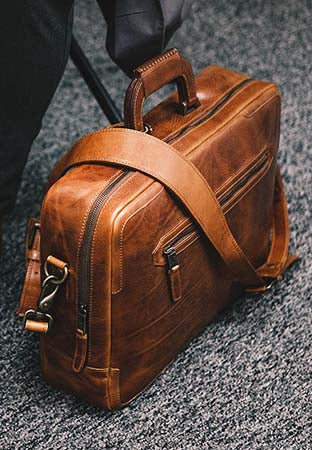From environmentally friendly leather production to natural cleaning solutions, discover how you can contribute to a greener future while maintaining the quality and integrity of your leather items.
The Sustainability of Leather
Leather is a sustainable material due to its durability and integration into a circular economy.
Unlike synthetic alternatives, it's a natural, biodegradable product and less impactful on the environment when managed responsibly. Studies highlight that properly managed leather production can have a much lower carbon footprint than synthetic materials, which rely on fossil fuels and are less degradable.
Furthermore, leather is essentially a byproduct of the meat industry, and utilizing it fully adheres to zero-waste, where every part of an animal is used to keep hides from ending up in landfills.
At Will Leather Goods, we also believe in a “tip-to-tail” philosophy to honor the animal by ensuring no waste of the leather we use.
Sustainable Leather Practices

Conscious consumer choices can significantly promote ethical practices when selecting sustainable leather. Supporting brands that prioritize sustainability enhances the quality of products and contributes to a more environmentally conscious industry.
By considering these key factors, you can ensure you’re supporting eco-friendly options that align with your values.
Certifications: Look for certifications from reputable organizations like the Leather Working Group (LWG) or Global Organic Textile Standard (GOTS), which signify adherence to environmental and ethical standards in leather production.
Leather origin: Opt for products made from leather sourced from responsible sources, such as food industry by-products or regenerative agriculture practices that promote sustainable land management.
Tanning processes: Prioritize leather goods that undergo eco-friendly tanning processes like vegetable tanning, which utilizes natural tannins in plants instead of harmful chemicals to reduce environmental impact. This is why we offer many vegetable-tanned leather products.
Eco-Friendly Leather Cleaning and Conditioning
Eco-friendly leather cleaning emphasizes maintaining the quality of leather goods without resorting to harmful chemicals. Regularly using these gentle cleaning and conditioning methods can help keep your leather items' natural look and feel without the harsh effects of chemicals.
Natural Cleaners for Leather
When using these natural cleaners, it's important to always do a spot test on a hidden area of the leather first to ensure no discoloration or damage.
Natural Baby Soap
This cleaner is ideal for users seeking a non-abrasive option to keep their leather looking its best. It cleans effectively without harsh chemicals, making it safe for frequent use on delicate leather.
- Mix: Blend a small amount of natural baby soap with warm water and add a few drops of white vinegar. Stir until the baby soap is fully dissolved to create a mild cleaning solution.
- Apply: Dip a soft cloth into the solution and wring out excess liquid.
- Clean: Gently wipe the leather surface with the damp cloth.
- Dry: After cleaning, wipe the leather with a dry cloth to remove any soap residue and let it air dry completely.
Lemon
When combined with water, lemon is a natural disinfectant and stain remover, ideal for tackling tough spots on leather items.
- Mix: Squeeze the juice of one lemon into a bowl and mix it with a cup of water.
- Apply: Dip a soft cloth into the lemon water, squeeze out the excess liquid to avoid dripping, and gently wipe the leather to address spots or general cleaning.
- Wipe: Use a separate damp cloth to remove any lemon residue from the leather.
- Dry: Finish by drying the leather with a soft, dry cloth and allow it to air dry thoroughly.
For stain removal, apply a small amount of lemon water directly onto the stain and let it sit for a few minutes before wiping it off with a damp cloth.
Vinegar
Known for its natural cleaning properties, vinegar can be diluted with water to create a gentle yet effective cleaner for leather surfaces. Its acidic nature helps remove dirt, grime, and smells without compromising the leather's integrity.
- Mix: Combine equal parts of white vinegar and water in a bowl. For a typical batch, mix 1/2 cup of vinegar with 1/2 cup of water.
- Apply: Dampen a soft cloth with the vinegar solution and wring it out until it is moist but not dripping.
- Clean: Gently wipe the leather surface with the dampened cloth. Be sure to cover the entire area, but avoid saturating any part of the leather.
- Dry: After wiping down the leather, use a clean, dry cloth to remove any excess moisture. Allow the leather to air dry away from direct heat or sunlight.
Natural Conditioners for Leather
These natural conditioners offer a safe and effective way to maintain the integrity and appearance of your leather goods, ensuring they last longer while looking great.
Remember, regular care and maintenance can significantly extend the life of your leather products.
Beeswax
Beeswax is excellent for waterproofing and protecting leather.
- Mix: Melt one part beeswax with one part carrier oil (like almond oil) to create a smooth paste.
- Apply: Use a soft cloth to apply a small amount of the paste to the leather.
- Condition: Work the mixture into the leather evenly, ensuring complete coverage.
- Dry: Allow the conditioner to absorb and set on the leather. Buff with a clean cloth for a polished finish.
Cocoa Butter
Cocoa butter deeply moisturizes leather, leaving it soft and richly hydrated.
- Mix: Soften the cocoa butter until it's easy to apply but not completely melted.
- Apply: Spread the softened cocoa butter over the leather using a cloth.
- Condition: Rub in thoroughly to ensure the leather absorbs the cocoa butter.
- Dry: Allow it to penetrate the leather for a few hours before buffing off any excess with a dry cloth.
Coconut Oil
Coconut oil is excellent for conditioning leather, providing a natural shine and suppleness.
- Mix: No mixing is required! Just use pure coconut oil.
- Apply: Add a small amount of coconut oil to a clean, soft cloth.
- Condition: Gently rub the oil into the leather in circular motions, covering the entire surface evenly.
- Dry: Allow the leather to absorb the oil naturally. Do not rinse! If necessary, buff with another dry cloth to remove excess oil.
Olive Oil
Olive oil naturally restores the flexibility and shine of leather.
- Mix: No need to mix! Use pure, light olive oil for a non-greasy finish.
- Apply: Lightly dab a cloth in olive oil and apply sparingly to the leather.
- Condition: Gently massage the oil into the leather in circular motions.
- Dry: Allow the leather to absorb the oil. Wipe off excess with a dry cloth to prevent stickiness.
Refer to our expert-written How To Clean Leather guide for further help cleaning and conditioning your leather items.
Eco-Friendly Practices for Leather Care and Maintenance

In addition to DIY solutions, regular maintenance practices can significantly prolong the life of your leather products to reduce waste and promote sustainability. Here are some tips to consider:
Keep leather moisturized: Regularly moisturizing helps prevent drying and cracking, extending the lifespan of leather items.
Store properly:
- Avoid exposing leather goods to direct sunlight or extreme temperatures, as these conditions can accelerate wear and tear.
- Store leather goods in a well-ventilated area to prevent moisture buildup, which can lead to mold growth and deterioration of the leather.
- Opt for breathable storage containers or fabric dust bags instead of plastic covers since plastic can trap moisture and damage leather over time.
Clean and protect: Regularly wipe leather surfaces with a soft cloth to remove dust and debris. Consider using protective sprays or creams to guard against stains and moisture, enhancing the longevity of the leather.
Embracing repair and reuse: When faced with minor damages or wear, consider repairing leather goods instead of discarding them. Learn to treat common issues like surface scratches or slight fading to extend the life of your leather items.
Embracing Sustainable Leather Care
Let's continue to nurture our leather goods with the utmost care, ensuring they last for generations and help keep our carbon footprint small.











